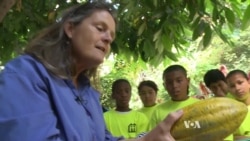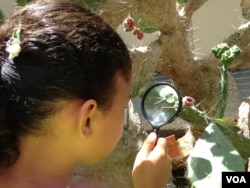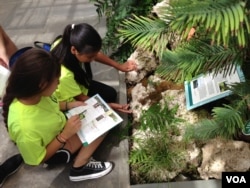Lee Coykendall teaches students from nearby Virginia all about the Theobroma cacao - the source of chocolate.
“This tree will have 30-40 pods, and inside, look!” she exclaimed under the shade of the large tree at the U.S. Botanic Garden in Washington.
Coykendall is the children’s education specialist at the Garden and on this weekday morning she was offering a group of middle schoolers an opportunity to learn how chocolate goes from flower to chocolate bar within a year.
During the presentation, the students held a large mango-sized pod, touched and smelled cocoa butter and cacao beans, and even tasted a piece of chocolate.
The hands-on demonstration made an impression on 12-year-old Kevin Rosales.
“I learned that chocolate is made from nuts,” he said. “Really big nuts - like a football.”
Wesley Martinez,14, was equally impressed.
“I learned that chocolate comes out of trees and I actually really did like the chocolate.”
The students were participating in a special program called Junior Botanist that’s designed by the Botanic Garden to teach them about plants.
Working in teams, they use booklets and tools from specially- equipped backpacks to explore seven special areas in the conservatory, including the Rare and Endangered area, a World Desert, a Primeval Garden and a section devoted to medicinal plants.
The student botanists used rulers to measure the thickness of bamboo, followed instructions in guidebooks to identify rare plants and used magnifying glasses to get close-up views of a spiny cactus, a particular favorite of 11-year old Jenny Martinez.
“Looking at the cactus and some plants that brought medicines…that was awesome,” she said.
“I got to see some pineapple and papaya plants,” said 12-year-old Katherine Alvarez. “It was fun and I liked it because I learned new things.”
Learning new things is the whole purpose of the program, said Coykendall, adding that it was deliberately designed to give students an experience they would never forget.
“At the Botanic Garden we are always looking for ways to bring our plants alive for people and especially for our younger visitors. Where our food comes from, where medicine comes from and to connect them with the magic of the plant world," Coykendall said.
Educator Cristina O’Brien said she appreciates and values that philosophy, and especially liked the hands-on aspect of the program.
“The kids are much more engaged when they get to be up, when they get to touch things, when they get to use a kit and explore," she said.
For Jenny Martinez, being able to explore the Garden as a Junior Botanist for a day was an inspiring experience.
“I want to be a botanist because it looks like fun because exploring plants and seeing what they do is fun,” she said.














